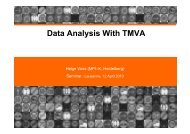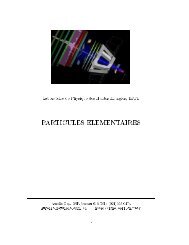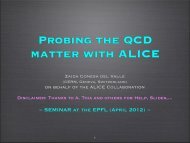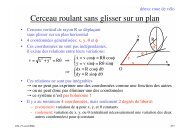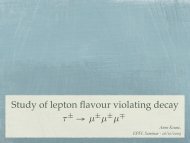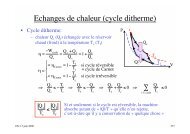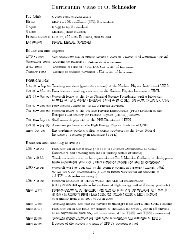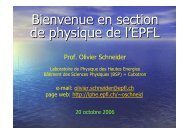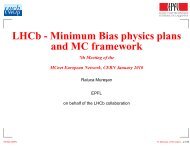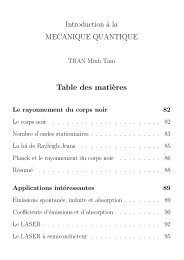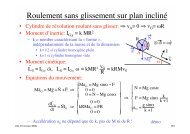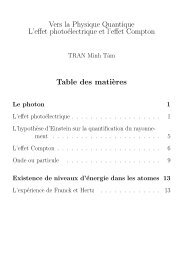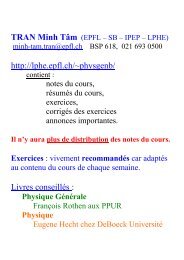pdf file - EPFL
pdf file - EPFL
pdf file - EPFL
You also want an ePaper? Increase the reach of your titles
YUMPU automatically turns print PDFs into web optimized ePapers that Google loves.
Measurement of mixing parameters<br />
of the B meson s meson at LHCb<br />
A.Hicheur, A.Hicheur,<br />
<strong>EPFL</strong><br />
Swiss Physical Society meeting<br />
February 20-21, 20 21, 2007<br />
1
Outline<br />
Physics motivation<br />
LHCb experiment<br />
Main steps of the study<br />
Results of sensitivity studies<br />
Conclusion<br />
2
Motivation<br />
LHCb Physics program: dedicated to b physics<br />
• All B s mixing parameters: Δms s , φs , ΔΓ<br />
ΔΓs s<br />
Bs→Dsπ, , b→c cbar s modes: J/ΨΦ J/ ΨΦ, , J/Ψη J/ Ψη, , η<br />
Sensitivity to new cΦ<br />
physics:<br />
• CKM angles α β and γ<br />
• Rare B decays<br />
Radiative, Radiative,<br />
electroweak, gluonic penguins<br />
Bs→μμ →μμ (rare box diagram)<br />
New particles in loop diagrams<br />
• Bc , b-baryon b baryon physics, charm physics, etc… etc<br />
B mixing and decays:<br />
Combined decays to CP eigen states and<br />
non CP eigen states to extract the mixing<br />
parameters:<br />
1. Precision measurement for Δms for CP eigenstates<br />
2. φs measurement<br />
(e.g e.g: : J/ΨΦ J/ ΨΦ, , J/Ψη J/ Ψη, , ηcΦ)<br />
For Bs→D -<br />
s π + , f ≠ f<br />
Small (φ ( s ) SM (-0.04): 0.04): possible<br />
early detection of New Physics<br />
3
Mixing and decay asymmetry for b → cc<br />
s modes<br />
Mixing: mass eigenstates ≠ CP eigenstates<br />
B = p B ± q B , ΔM<br />
= M − M , ΔΓ = Γ − Γ<br />
L / H<br />
q<br />
q<br />
Mixing phase φs= = 2Arg[V *<br />
Mixing ts Vtb<br />
Mixing phase φ tb] ] for B s +φNP s<br />
NP with new physics<br />
q<br />
H<br />
L<br />
q<br />
L<br />
H<br />
Decay<br />
Final phase for asymmetry ratio ≈ φs s (+φ (+ NP )<br />
Time dependent asymmetry: extraction of<br />
φs and ΔΓ s (ΔMs obtained from control<br />
sample B 4<br />
s→D -<br />
s π + )
pp collisions @ 14 TeV<br />
Correlated forward<br />
production σb ≈ 500 μb<br />
Forward spectrometer<br />
Primary<br />
vertex<br />
LHCb experiment<br />
bb<br />
Need prim. & b vertex reco for<br />
time measurements +<br />
subsequent decays separation<br />
B signal<br />
Vertexing<br />
D<br />
≈ 1 cm btag Flavour tagging<br />
K<br />
π<br />
RICH system for PID<br />
Tracking Muon detector<br />
PID to identify K/ π<br />
5
Channels for mixing parameters determination<br />
Admixture of CP eigenstates (ηη f = -1,+1) 1,+1)<br />
• Bs→J/ J/Ψ(μ + μ- )Φ(K (K + K- )<br />
Large yield but angular analysis to disentangle final states<br />
CP Even eigenstates (ηη f = +1)<br />
• Bs→J/ J/Ψ(μ + μ- )η(γγ γγ,π + π-π0 ), J/Ψ(μ J/ + μ- )η’(π + π- η,ρ0γ), ),<br />
ηc(h (h + h-h + h- )Φ(K (K + K- )<br />
Low yield, high background<br />
• Bs→ D +<br />
s (K + K-π + )Ds )D - (K + K-π- )<br />
Low yield, degradation of proper time resolution<br />
Extraction of ΔMs using flavor-specific flavor specific control<br />
channel<br />
• Bs→D -<br />
s (K + K-π- )π +<br />
6
Basic ingredients for the analyses<br />
Candidate selection<br />
• Bs mass resolution<br />
Proper time<br />
• Vertex/time resolution and time-dependent time dependent efficiency ε(t) (t)<br />
Tagging<br />
• Mistag rate and tagging efficiency<br />
Full Monte Carlo simulation results (based on 2 fb -1 )<br />
J/Ψ J/ η’(π + π- η(γγ γγ)) ))<br />
2.2<br />
1.0<br />
19<br />
33.0<br />
19<br />
31<br />
64<br />
7
Ideal rate<br />
B -<br />
s→Ds π + decay rates and ΔMs e<br />
2<br />
ΔΓst<br />
(cosh ± cos ΔM<br />
t)<br />
2<br />
( ( ) )<br />
) ( −<br />
−ΔΓst<br />
R B s t → Dsπ<br />
∝<br />
s<br />
+ dilution from flavour tagging<br />
e<br />
2<br />
ΔΓst<br />
(cosh ± D cos ΔM<br />
t)<br />
2<br />
( ( ) )<br />
) ( −<br />
−ΔΓst<br />
R B s t → Dsπ<br />
∝<br />
s<br />
+ Proper time resolution ~40 fs<br />
R<br />
( ) ( −<br />
true<br />
true rec<br />
B s ( t ) → Dsπ<br />
) ⊗G(<br />
t − t , Στσ<br />
τ )<br />
+ Background S/B ~ 3<br />
+ Acceptance<br />
( −)<br />
rec<br />
true<br />
true rec<br />
ε ( t ). R(<br />
B s ( t ) → Dsπ<br />
) ⊗G(<br />
t − t , Στσ<br />
τ )<br />
1000<br />
1000<br />
Events 800<br />
800<br />
600<br />
600<br />
400<br />
400<br />
200<br />
200<br />
Perfect Perfect Perfect reconstruction<br />
reconstruction<br />
reconstruction<br />
+ + flavour flavour tagging<br />
tagging<br />
+ proper time resolution<br />
resolution<br />
+ background<br />
+ acceptance<br />
0<br />
0<br />
0 0 1 1 2 2 2 3 3 4 4 5<br />
5<br />
Proper Proper Proper time time time (ps)<br />
(ps) (ps)<br />
8
B →J/ J/Ψ(μ s + μ- )Φ(K (K + K- ) case<br />
Transversity amplitudes:<br />
A0, , A // (CP even) A ⊥ (odd)<br />
One angle distribution:<br />
μ -<br />
z<br />
θ<br />
J/ψ J/<br />
Γ(<br />
Bs ( t)<br />
→ f ) ∝ ( 1−<br />
RT<br />
) Γ(<br />
Bs<br />
( t)<br />
→ feven)<br />
+ RT<br />
Γ(<br />
Bs<br />
( t)<br />
→ fodd<br />
)<br />
B s<br />
φ s<br />
μ +<br />
K +<br />
K -<br />
9
Toy Monte Carlo sensitivity studies<br />
From full MC, extract PDFs to model signal and<br />
background<br />
• Mass distributions<br />
• Proper time distributions (including acceptance, tagging,<br />
resolution model)<br />
• Transversity angle θ for Bs→J/ J/ΨΦ ΨΦ<br />
Generate ~ 200 toy experiments, each of them corresponds<br />
to 2 fb -1 of data<br />
• Likelihood maximized for b→ b c⎯c s modes simultaneously with<br />
control sample Bs→Dsπ Standard Model (or measured) values used for the input<br />
parameters:<br />
• M(B s) ) = 5369.6 MeV/c 2 , ΔMs = 17.5 ps -1<br />
• φs s = -0.04 0.04 rad, rad,<br />
ΔΓ s /Γs s = 0.15, τs = 1/Γ 1/ s = 1.45 ps<br />
• RT = 0.2 for Bs→J/ J/ΨΦ ΨΦ<br />
Fitted parameters: φs, , ΔMs, s , ΔΓs<br />
(+ R tag)<br />
, Γ s<br />
ΔΓs (+ RT, ωtag 10
PDF modeling, examples<br />
Bs (→Dsπ) ) mass<br />
Transversity angle for Bs→J/ J/ΨΦ ΨΦ<br />
total<br />
CP even<br />
CP odd<br />
bkg<br />
Proper time model for Bs→J/ J/ΨΦ ΨΦ<br />
total<br />
bkg<br />
Proper time PDF: convolution<br />
(ε(t rec ).R(t true ,ωtag CP-even CP even<br />
component<br />
tag ) (acceptance<br />
function×decay<br />
function decay rate)<br />
⊗ G(t rec – t true , Στστ) ) (resolution function)<br />
- στ (per event) proper time error<br />
- Στ scaling factor to account for bad error<br />
11<br />
estimation
Results for the sensitivities (2 fb -1 )<br />
φs sensitivity<br />
Other mixing parameters<br />
Parameters Sensitivity Decay<br />
ΔΓ s /Γs R T<br />
ΔM s<br />
ωtag tag<br />
σ(φs) ) vs φs B s →η c Φ<br />
Bs→J/ J/ΨΦ ΨΦ<br />
0.0092 Bs→J/ J/ΨΦ ΨΦ<br />
0.0004 Bs→J/ J/ΨΦ ΨΦ<br />
0.007 ps -1 Bs→Dsπ 0.0036 Bs→Dsπ 12
Conclusions<br />
Precision measurement for ΔMs φs s is unmeasured (yet)<br />
LHCb combined statistical sensitivity to φs s is 0.02<br />
for 2 fb -1 1 (a 2σ 2 measurement for a SM value)<br />
• Dominated by Bs→J/ J/ΨΦ ΨΦ<br />
• With the same statistics, ability to detect deviation due to<br />
new physics<br />
• First results expected for 2008. More precision afterwards<br />
More improvement to come<br />
• Adding J/Ψ→e J/ + e- mode increases yield by ~ 20%<br />
• Full angular analysis for Bs→J/ J/ΨΦ ΨΦ<br />
• Optimize use of Bs→Dsπ to determine the tagging<br />
performance of the b→ c⎯c s modes<br />
• Systematics studies<br />
13
Back up<br />
14
∝<br />
∝<br />
∝<br />
∝<br />
Decay rates<br />
b→ c⎯c s modes<br />
B s →D s - π +<br />
15
Decay diagrams<br />
Dominant tree Penguin contribution<br />
∝ λ 2 ∝ λ 4<br />
u<br />
d −<br />
π<br />
16
Tagging performance<br />
e, , μ from semi-leptonic<br />
semi leptonic decays<br />
K ± from the b→c c →s<br />
jet/vertex charge<br />
tagging B<br />
same side π/K /K signal B<br />
Tagging power εD2 = ε(1 (1−2ωω tag)<br />
tag<br />
2 (in %)<br />
Tag εD2 Muon 1.0<br />
Electron 0.4<br />
Kaon 2.4<br />
Jet/vertex<br />
charge<br />
1.0<br />
Same side 2.1<br />
Combined tagging power<br />
for B S in LHCb is ~ 6%<br />
Note ~2% at the Tevatron<br />
~30% at B-Factories Factories<br />
Tagging power for B 0 ~ 4%<br />
(reduced reduced same side tagging) tagging<br />
Recent Neural Network based study achieved 9% for B S tagging!<br />
tagging<br />
17
More sensitivity plots<br />
σ(φs) ) vs ΔΓ s /Γs σ(φs) ) vs RT 18



